How to Clean an Espresso Machine
Does your morning shot of espresso taste off? Milk suddenly slow to foam? Your espresso machine may slowly regress in terms of quality and efficiency, suddenly escalating to a noticeable breaking point. But it's not broken! It's just time to give it a solid deep clean.
While you should always refer to your owner's manual, it's also helpful to hear how the pros approach cleaning this dependable, caffeine-delivering workhorse. That's why we connected with John Holmquist, Coffee Professional, Seattle Coffee Gear Commercial and Residential Sales Manager. To help distinguish between the many (hundreds, if not thousands) of espresso machines on the market, he breaks it down:
"Superautomatic, or machines that are push-button and dispense your espresso automatically, require less manual maintenance. They automatically flush and rinse after brewing, often feature built-in water filtration systems, and generally have programmed reminders to alert you of cleaning needs."
He continues, "On the other hand, semi-automatic machines are in most cases on the manual side, and are more labor-intensive. Most parts need to be cleaned manually, and consumables like gaskets need to be replaced over time."
With proper maintenance, thorough cleanings, and routine tune-ups, many higher-end espresso machines can last a decade or more. "It’s a bit like a car," compares Holmquist. "Take care of it and it’ll run for years and years."
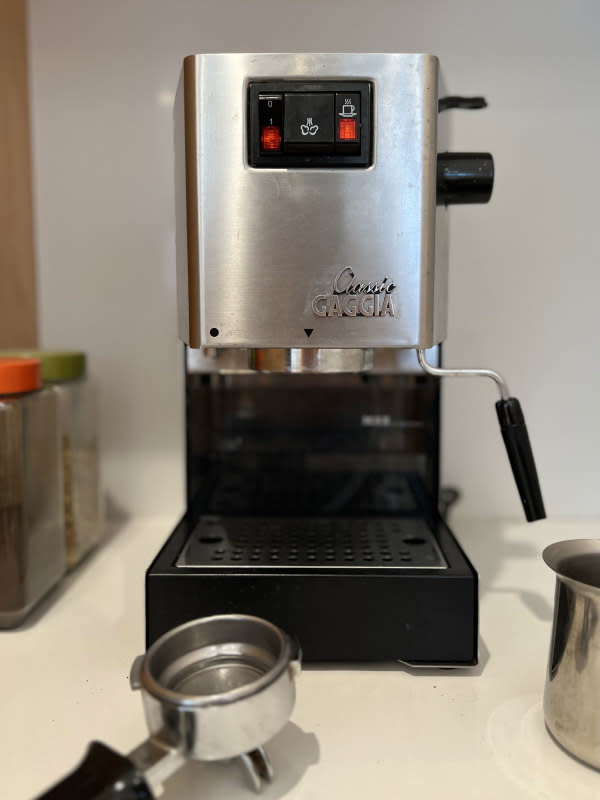
Emily Fazio
Signs That You Need to Clean Your Espresso Machine
Bad-tasting espresso. It might taste bitter, burnt, stale, or just "off."
Your coffee looks “thin”
The machine sounds rough during the brewing process
"If your machine has any of these symptoms, backflushing is a great place to start," shares Holmquist. "Backflushing removes any old coffee residue that is contributing to those unpleasant flavors. The longer you wait to clean buildup from coffee, the more pronounced these changes can become."
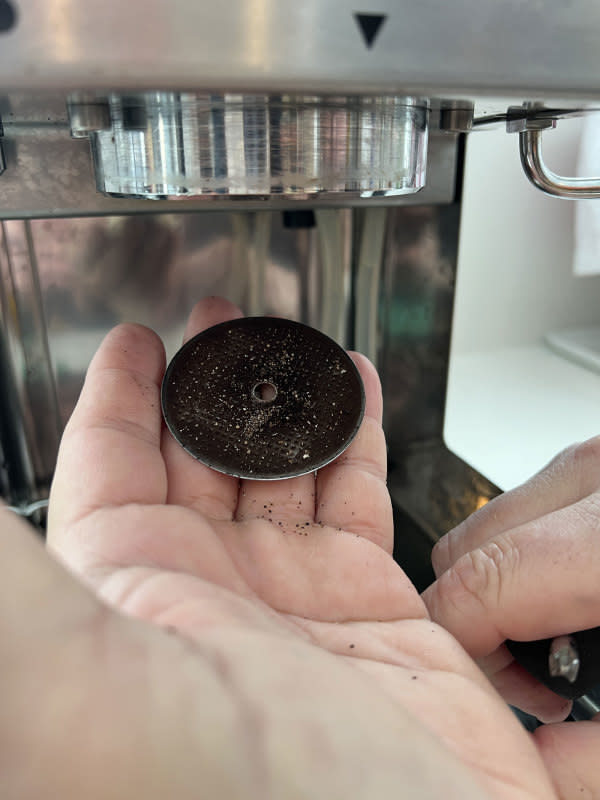
Emily Fazio
How to Backflush an Espresso Machine
Depending on your usage, it's recommended to backflush your espresso machine every 1-2 weeks; however, since it varies, it's best to monitor the machine's performance.
Gather Supplies: You'll need a backflush disc or blind filter (a filter with no holes), espresso machine cleaner (specifically designed for backflushing), a clean towel or cloth, and a brush.
Prepare the Machine: Make sure the espresso machine is turned off and cool. Remove the portafilter handle and basket. Insert the backflush disc into the portafilter.
Add Cleaner: Depending on the cleaner you're using, follow the manufacturer's instructions to add the appropriate amount to the blind brew basket filter.
Backflush: Insert the portafilter into the group head. Start the backflush cycle according to your machine's instructions. Typically, this involves running the pump for a few seconds, then pausing for a moment, and repeating this process several times. The goal is to create pressure that forces the cleaning solution in the blank portafilter basket through the machine's internal components.
Remove and Rinse: After backflushing, remove the portafilter and rinse it thoroughly under running water. Also, rinse the blank portafilter basket to remove any residue.
Clean the Group Head: Use a brush to clean the group head thoroughly. Pay attention to the gasket and the filter screen to remove the remaining bit of coffee oils or coffee scale buildup.
Reassemble: Once everything is clean and rinsed, reassemble the portafilter with its basket and insert it back into the group head.
Flush with Water: Run a few cycles of fresh water through the group head to rinse out any remaining cleaner.
Wipe Down: Use a clean towel to wipe down the exterior of the machine and any surfaces that may have come into contact with the cleaning solution.
Cleaning Individual Parts On a Semi-Automatic Espresso Maker
1. Clean the Portafilter Basket
Remove the filter basket from the machine and rinse it under hot water to remove any remaining espresso residue.
Use a brush to scrub the inside of the basket to remove any stubborn coffee oils.
Periodically, you may want to soak the portafilter in a solution of water and espresso machine cleaner to dissolve any built-up oils.
Rinse thoroughly afterward.
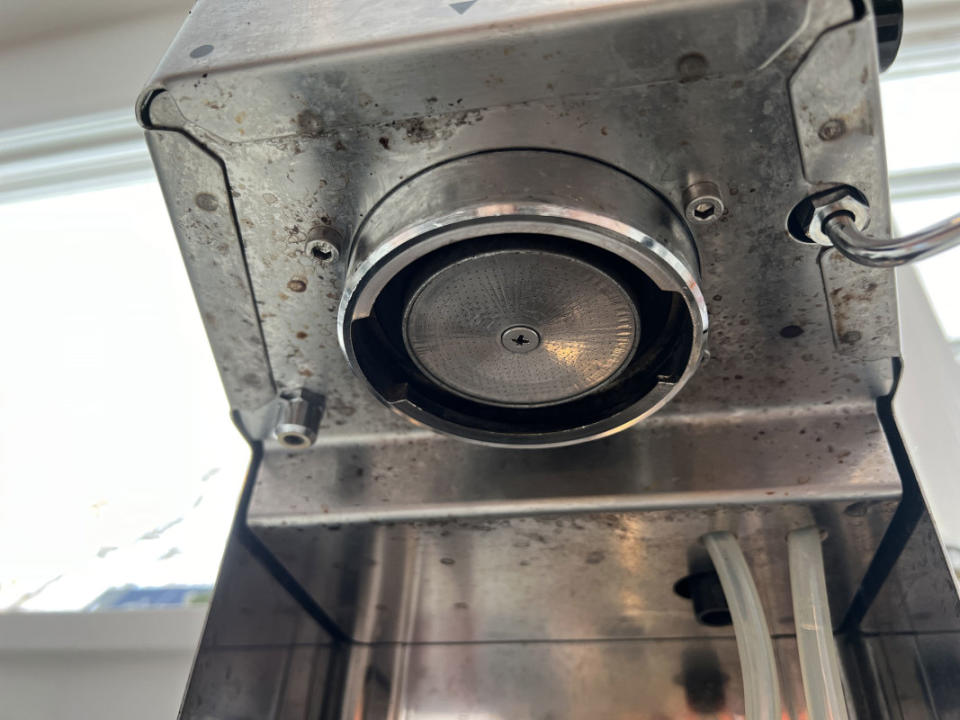
Emily Fazio
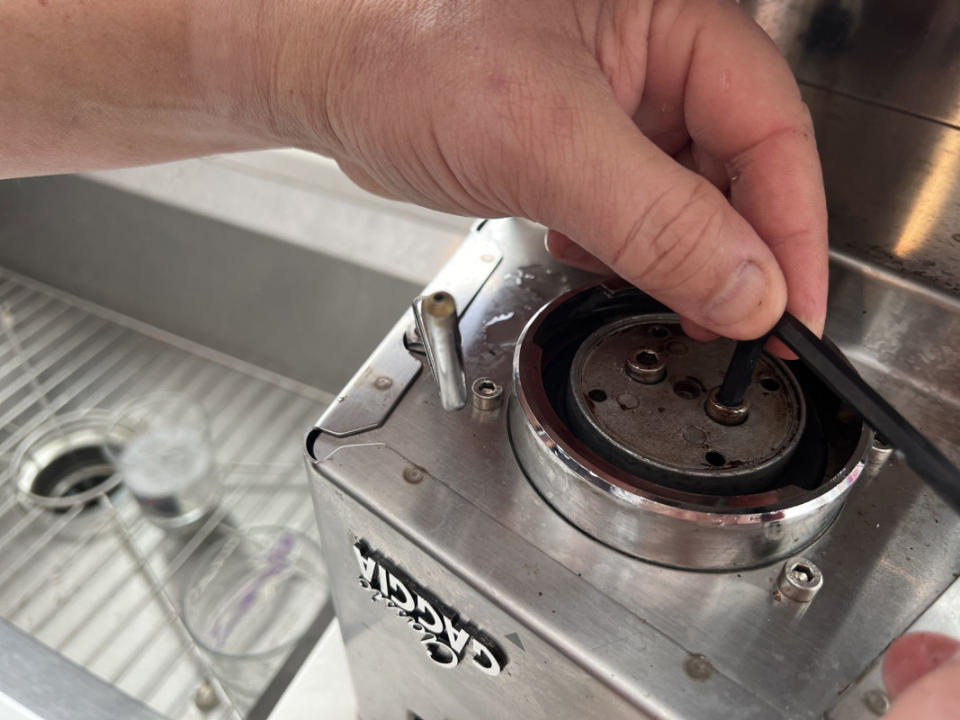
Emily Fazio
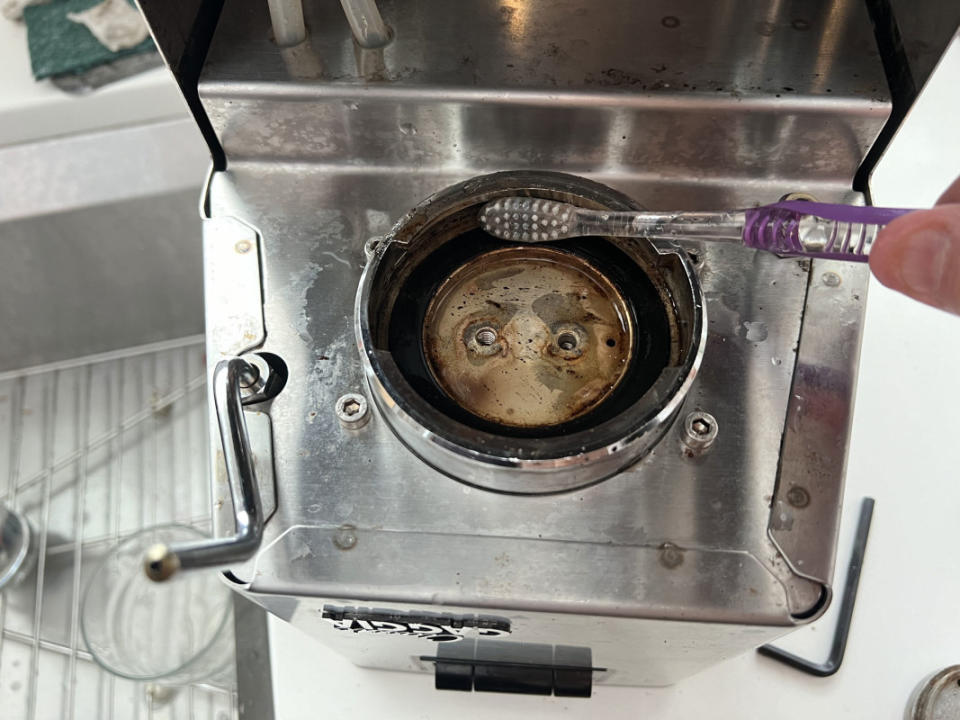
Emily Fazio
2. Clean the Group Head
Wipe the group head with a clean, damp cloth to remove any coffee grounds or residue.
While you might be able to use a brush to clean the gasket and the area around the shower screen, it's also worth deep cleaning the group head periodically because in many machines, you can't thoroughly clean without a little disassembly.
With the machine unplugged and flipped upside down, we periodically disassemble the group head to remove the dispersion screen and clean the inner workings. It might look like a clean filter screen from the outside, but there will be lot of black coffee particles on the inside.
If necessary, use a small amount of espresso machine cleaner on a toothbrush to scrub away any stubborn residue and lingering espresso grounds.
Be sure to rinse well with clean water.
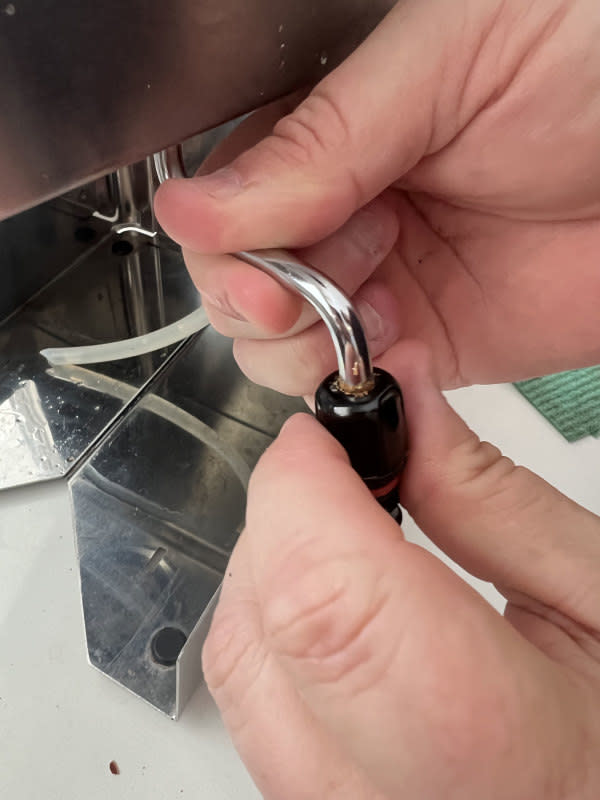
Emily Fazio
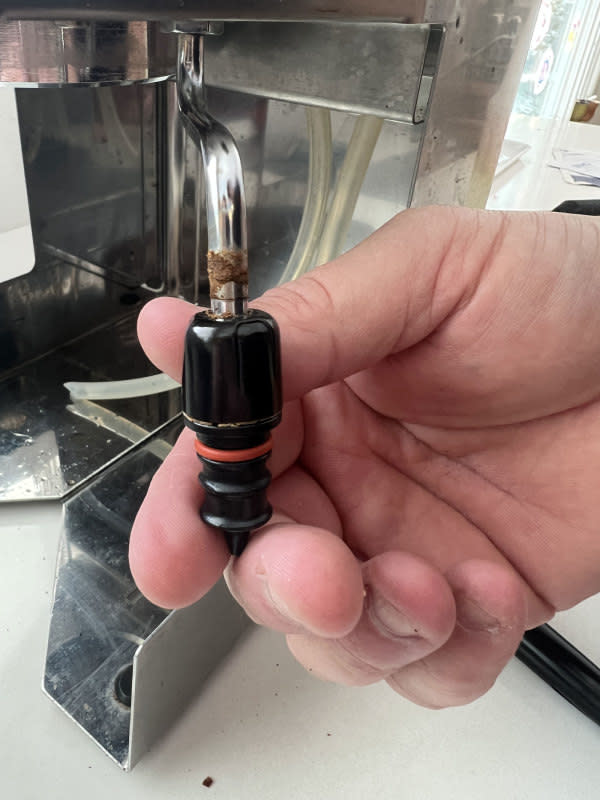
Emily Fazio
3. Clean the Steam Wand
Though it's routine to purge the steam wand by releasing a short burst of steam to clear any milk buildup, it still collects around and inside the internal connections.
Remove the steam tip, steam pipe wand, and all connections. As you disassemble, you'll begin to see how much old milk has dried up, affecting the flow of steam.
Soak all components in warm, soapy water to loosen any dried milk residue.
Rinse before reassembling.
4. Clean the Drip Tray and Water Reservoir
Remove the drip tray and empty any liquid.
Wash the drip tray with warm, soapy water and rinse thoroughly.
If it's dishwasher-safe, you can also run it through the dishwasher.
Clean the water reservoir regularly with mild dish soap and warm water.
Clean the exposed water lines with a damp cloth to reduce water film that collects on surfaces.
Rinse thoroughly to remove any soap residue.
5. Clean the Exterior
Wipe down the exterior of the espresso machine with a clean cloth regularly to remove any dust or spills.
If stainless steel, use a proper cleaner to eliminate water spots and streaks.
Advice For Descaling an Espresso Machine
Before you use the first descaling cleaner you find on Amazon, check your manufacturer's manual. Some products require a manual descaling, while others have an automatic system. Furthermore, different machines require different ratios of commercial descaling product to water. Following your manual will ensure that you can remove unwanted mineral deposits that affect how the machine works.
Holmquist also weighs in, sharing, "If your machine’s manual mentions the descaling process and your machine doesn’t have a reminder system built-in, just keep an eye on its performance. If you notice that your machine is taking longer to heat up or sounds off, it may be time to use a descaling agent." To reduce the frequency of descaling, especially on higher-end machines, he recommends, using soft-filtered or spring water to avoid mineral buildup in the first place.
Related: The Easy Way to Clean a Showerhead
How often do you need to clean your espresso machine?
"This is a tricky question because it depends on usage, regular cleaning regimen, and guidance from the manufacturer," says Holmquist. "It’s a good idea to do some basic cleaning after every use, like flushing your brew head with hot water before and after each shot, purging and wiping down your steam wand if used, wiping out your portafilter between shots, and giving the machine a general wipe down after you are finished brewing for the day."
If your machine has a water filter, remember to change it. "At a minimum, we recommend changing it every 3 months," recommends Holmquist "With regular cleaning you can ensure that your machine functions well for a very long time, but a deeper clean is useful to take care of oil or residue buildup in places that you don’t always hit with a regular clean. It's a chance to really refresh your machine to make it look/feel like new again."
